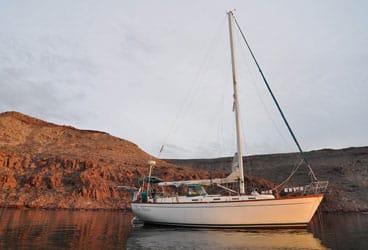
Fuji40
Japan is rarely mentioned as a country where cruising sailboats were built, but in the decade beginning in 1973, Fuji Yacht Builders of Yokosuka turned out roughly 230 boats for sale in the United States. The models ranged from 32 to 45 feet.
The company’s Fuji 40 sprang from Sparkman & Stephens design number 2292. Unlike its full-keeled siblings, it has a long fin keel with a rudder hung on a full skeg. Yet despite the performance promised by its modern underbody, this is a very heavy boat and requires a fresh breeze to reach its 7.4-knot hull speed. But that’s an easy trade-off for a solidly built craft that offers a roomy interior and a seakindly motion.
Under sail, our Fuji 40, Del Viento, is rock steady and stable. It’s easy to trim to a course and then leave the helm for a minute without her veering off or heading up. Sailing in rougher weather, she plows through steep chop without being tossed around or grinding to a halt. She’s a dry boat while under way, and spray rarely reaches the crew, which I attribute to the Fuji 40’s distinctive high freeboard.
The mainsheet traveler is located just aft of the companionway, handy when the helmsman needs to adjust mainsail trim while the boat is sailing but often an obstacle for crew going below. When the boat is under power or at anchor, a port-side boom crutch keeps the companionway entry clear.
| LOA | 39′ 2″ |
| LWL | 31′ 0″ |
| Beam | 12′ 8″ |
| Draft | 6′ 0″ |
| Sail Area (100%) | 776 sq. ft. |
| Ballast | 8,000 lb. |
| Displacement | 27,065 lb. |
| Ballast/D | .30 |
| D/L | 406 |
| SA/D | 13.8 |
| Water | 100 gal. |
| Fuel | 50 gal. |
| Engine | 40-hp. Westerbeke |
| Designer | Sparkman & Stephens |
From the bow to the companionway, the layout is conventional: anchor locker, V-berth, head, closet, settees, pedestal table with fold-up leaves, galley, and nav station. It’s aft of the companionway where the interior design of this aft-cockpit boat shines: It has a large aft cabin with a generous double berth to port, a single to starboard, and drawers and a seat between them—and standing headroom.
Headroom everywhere is generous (up to 6 feet 10 inches), adding to the spaciousness below. However, my wife, who stands 5 feet 4 inches, can’t reach the support to prop open the center hatch.
Throughout the boat, cabinetry is constructed of teak and makore hardwoods. Fit and finish are exemplary. On our boat (hull number 4), doors and drawers still fit nicely and glide smoothly after 34 years.
The hull of the Fuji 40 is thick, hand-laid fiberglass up to the toerail, and the ballast is encapsulated iron. The decks are foam-cored. Fuji fitted 40-horsepower Westerbeke auxiliaries, but many will have been replaced. Engine access is excellent forward and aft but poor on either side.
On our boat, we replaced the original eight plastic deadlights with stainless-steel opening ports, which brought a welcome increase in ventilation. We strengthened the bow pulpit by adding horizontal and vertical supports and stiffened the gate stanchions and stern pulpit with braces to the teak toerail. The deck lacks efficient scuppers. The toerail is continuous, and water can only escape through three half-inch drains on each side that discharge a few inches below the sheer.
Fuji built just over a dozen Fuji 40s, the last in 1979, and recent asking prices have ranged from $79,000 to $110,000. For a comfortable, roomy, well-constructed cruising boat with an S&S pedigree, it’s hard to go wrong at those prices.
New CW bloggers Michael Robertson and his wife, Windy, are cruising with their two daughters along the western coast of the Americas aboard their Fuji 40. Go to www.cruisingworld.com/blogs/log-of-del-viento to follow their travels.








